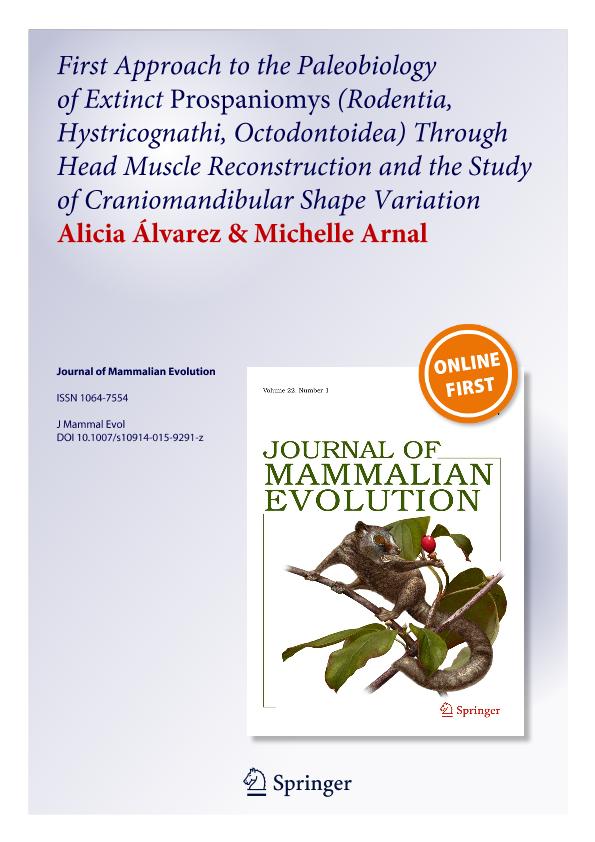Mostrar el registro sencillo del ítem
dc.contributor.author
Alvarez, Alicia

dc.contributor.author
Arnal, Michelle

dc.date.available
2017-06-28T20:31:56Z
dc.date.issued
2015-03
dc.identifier.citation
Alvarez, Alicia; Arnal, Michelle; First Approach to the Paleobiology of Extinct Prospaniomys (Rodentia, Hystricognathi, Octodontoidea) Through Head Muscle Reconstruction and the Study of Craniomandibular Shape Variation; Springer; Journal of Mammalian Evolution; 22; 4; 3-2015; 519-533
dc.identifier.issn
1064-7554
dc.identifier.uri
http://hdl.handle.net/11336/19056
dc.description.abstract
Prospaniomys is a basal octodontoid recorded in the early Miocene in Patagonia (Argentina; Colhuehuapian SALMA). Nearly complete cranial and mandibular remains known for this genus provide a unique opportunity to explore its paleobiology. For this, masticatory muscles were reconstructed and craniomandibular shape variation assessed. While such reconstruction indicates that most masticatory muscles would have presented moderate development, both the masseter lateralis and posterior muscles were poorly developed. In contrast, we found that the temporalis muscle was well developed, while conspicuous postorbital constriction, postorbital processes, and superior temporal lines revealed a substantial orbital portion of this muscle. According to geometric morphometric results, craniomandibular shape was interpreted as generalized. Features such as shortened palate, narrower bizygomatic width, orthodont incisors, enlarged incisive foramina, and a shallow jaw could be linked to epigean habits. The moderate development of auditory bullae in Prospaniomys suggests that it is unlikely that it may have lived in extreme arid environments. Additionally, based on its generalized dental morphology, an omnivorous or generalized herbivorous diet that may have included leaves, fruit, and potentially animal matter was inferred. By the early Miocene, Patagonia experienced the initial expansion stage of arid-adapted vegetation, with grasses present in low amounts and abundant forests. Generalized habits and soft and nonabrasive diet suggest that Prospaniomys was possibly associated with more closed environments. Morphology alone cannot be used as an environmental proxy, but it could undoubtedly contribute to the interpretations based on data provided by paleobotanical and geological frameworks in studies on the evolution of environments.
dc.format
application/pdf
dc.language.iso
eng
dc.publisher
Springer

dc.rights
info:eu-repo/semantics/openAccess
dc.rights.uri
https://creativecommons.org/licenses/by-nc-sa/2.5/ar/
dc.subject
CAVIOMORPHS
dc.subject
EARLY MIOCENE
dc.subject
FUNCTIONAL MORPHOLOGY
dc.subject
GEOMETRIC MORPHOMETRICS
dc.subject
MASTICATORY MUSCLES
dc.subject.classification
Paleontología

dc.subject.classification
Ciencias de la Tierra y relacionadas con el Medio Ambiente

dc.subject.classification
CIENCIAS NATURALES Y EXACTAS

dc.title
First Approach to the Paleobiology of Extinct Prospaniomys (Rodentia, Hystricognathi, Octodontoidea) Through Head Muscle Reconstruction and the Study of Craniomandibular Shape Variation
dc.type
info:eu-repo/semantics/article
dc.type
info:ar-repo/semantics/artículo
dc.type
info:eu-repo/semantics/publishedVersion
dc.date.updated
2017-06-28T19:41:54Z
dc.identifier.eissn
1573-7055
dc.journal.volume
22
dc.journal.number
4
dc.journal.pagination
519-533
dc.journal.pais
Estados Unidos

dc.journal.ciudad
New York
dc.description.fil
Fil: Alvarez, Alicia. Consejo Nacional de Investigaciones Científicas y Técnicas. Oficina de Coordinación Administrativa Parque Centenario. Museo Argentino de Ciencias Naturales "Bernardino Rivadavia"; Argentina
dc.description.fil
Fil: Arnal, Michelle. Universidad Nacional de La Plata. Facultad de Ciencias Naturales y Museo. Departamento Científico de Paleontología de Vertebrados; Argentina. Consejo Nacional de Investigaciones Científicas y Técnicas. Centro Científico Tecnológico Conicet - La Plata; Argentina
dc.journal.title
Journal of Mammalian Evolution

dc.relation.alternativeid
info:eu-repo/semantics/altIdentifier/doi/http://dx.doi.org/10.1007/s10914-015-9291-z
dc.relation.alternativeid
info:eu-repo/semantics/altIdentifier/url/https://link.springer.com/article/10.1007%2Fs10914-015-9291-z
Archivos asociados
